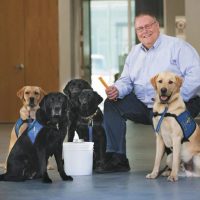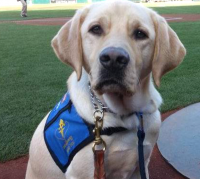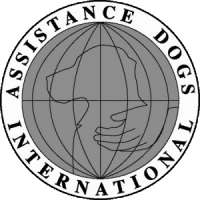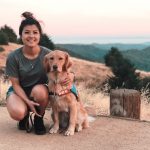By Mark Ruefenacht, NIST Guest Researcher and Contract Instructor
Editor’s Note: Published on the National Institute of Standards and Technology (NIST) Intranet February 9, 2017 and distributed to employee’s and associates via “NIST Connections” newsletter on February 14, 2017.
Have you seen him on the Gaithersburg campus? He’s tall, blonde, handsome, and always friendly…with four paws and a tail?
His name is Hollis, he is a yellow Labrador retriever, and he is a remarkable ambassador for the story I’m about to tell about an earlier dog of mine, Armstrong, who is recognized in Guinness World Records 2015 as the first diabetic-alert dog in the world.
On a cold winter New York City night in 2001, my life was saved by a guide-dog-in-training. I am an insulin-dependent diabetic, and that night, I made a crucial error—I did not check my blood sugar before going to sleep.
 During the night, unbeknownst to me, I was slipping into a severe low-blood-sugar episode (hypoglycemia). Most likely, my low blood sugar caused a seizure in my sleep, and a 12-month-old puppy I was training to be a Guide Dog for the Blind recognized that I was in distress and woke me from my hypoglycemic haze.
During the night, unbeknownst to me, I was slipping into a severe low-blood-sugar episode (hypoglycemia). Most likely, my low blood sugar caused a seizure in my sleep, and a 12-month-old puppy I was training to be a Guide Dog for the Blind recognized that I was in distress and woke me from my hypoglycemic haze.
I recovered from this terrifying event. But, it sparked an idea to merge two aspects of my life into one experiment. As a metrologist working in forensics, I was working on breathalyzer technology.
I also dedicated a large amount of my time training service dogs. This experience in New York brought the two pieces of my life together; I began investigating a dog’s ability to decipher human breath. In particular to distinguish the chemicals associated with diabetic hypoglycemia.
I began my volunteer work training guide dogs in 1996 because of the probability that I will need a guide dog in the future if I develop diabetic blindness. I wanted a way to pay-forward to the organization Guide Dogs for the Blind that I believed would provide me with the life-changing services of a guide dog as my diabetes progresses.
My episode in that New York hotel room, my work with Guide Dogs for the Blind, and my experience in forensic metrology culminated into my hypothesis that I could train a dog to detect hypoglycemia from the scent of my breath.
But, more importantly, I wondered if training such a diabetic-alert dog could cause it to accurately and repeatable detect a dangerous level of hypoglycemia?
Armstrong
Because of my familiarity with training guide dogs for the blind, it was a natural fit that a yellow Labrador retriever, named Armstrong, would be repurposed from guide work and pilot my experiment.
After five years of research and a year working on this hypothesis with Armstrong, I officially proved that I could train a dog to detect life-threatening drops in blood sugar from the chemical changes in a person’s scent, and that this scent was universal among severely hypoglycemic diabetics.
* This breakthrough meant Armstrong could detect my changes in blood sugar, as well as any other diabetic’s blood-sugar changes. In 2004, I founded a first-of-its-kind organization, Dogs4Diabetics, in my hometown in the San Francisco East Bay, and began fundraising to share this research and provide certified medical-alert assistance dogs for other insulin-dependent diabetics.
Dogs4Diabetics has trained and placed more than 150 dogs with insulin-dependent diabetics. The dogs are the first ever to be accredited by Assistance Dogs International for scent-discrimination work related to diabetes and medical-alert.
The dogs are trained to alert their handler when the dog identifies the scent associated with dropping blood-sugar levels, typically below 70 milligrams per deciliter. So, the handler can treat the low sugar level before suffering the symptoms of hypoglycemia and potential incapacitation.
These dogs are specifically trained for scent discrimination and to differentiate smells down to the level of parts per million. These dogs outperform current technology available to diabetics to detect and alert them to dropping blood-sugar levels.
The dogs at the Dogs4Diabetics Nylabone Training facility are taught using positive reinforcement. If a dog correctly alerts its owner to a change in blood sugar. The dog is rewarded with a positive interaction and a tasty treat.

Diabetic-Alert Dog Hollis
After an extensive scent-discrimination training process, the dogs are issued to clients who have been trained on the use and care of a service dog.
All the diabetic-alert dogs have been provided by and repurposed from Guide Dogs for the Blind. The dogs chosen for training have traits such as being sniffy and playful that are ideal for scent-detection work (and less ideal for guide work).
To me, the best part about founding Dogs4Diabetics is the connection with clients. I get to meet diabetics who come into the program, and watch their life literally change because they get so much more control over their diabetes. I also love working with the dogs.
They give unconditional love, loyalty and forgiveness. There are so many traits in dogs that people aspire to achieve and these dogs already have them. The power is in the human-dog bond. Both sides have to work to make it positive.
Diabetic-Alert Dog Hollis
My current service dog, Hollis, and I can frequently be seen on the NIST Gaithersburg campus. I work part time as a guest researcher and contract instructor teaching classes for the NIST Office of Weights & Measures on topics of metrology, metrological traceability, uncertainty of measurement, mass calibration, and balance calibration.
Also, I serve on the Toxicology Committee of NIST’s Organization of Scientific Area Committees for Forensic Science , and I am an ISO/IEC 17025 lead and calibration technical assessor for NIST’s National Voluntary Laboratory Accreditation Program .
Additionally, I am recognized internationally for discovering the science of scent related to diabetes. I am working today on developing standards of excellence and quality for medical-alert service dogs.
Diabetic-Alert Dog, Hollis, embodies the Dogs4Diabetics motto: “Our Dogs Save Lives.”
For more information, visit dogs4diabetics.com and view this short YouTube video (below). Be sure to say hello when you see us on campus.
* I used my NIST metrology training to design and implement our unique canine training program. I have established a method of creating certified reference materials (using highly trained “proof dogs” with thousands of data points and degrees of freedom that serve as “check standards”), measurement/quality assurance, statistical controls, confidence intervals about the accuracy claims




